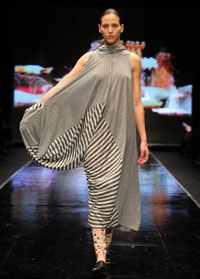For the first time in 30 years, Israeli fashion designers, models and journalists gathered together for Tel Aviv Fashion Week, or TLV-FW, a three-day extravaganza showcasing Israeli design (November 21-24).
The 600 attendees, including more than two dozen designers and foreign and local journalists, were all part of the grand plan to publicize Israeli fashion, said organizer Ofir Lev, deputy CEO of the
Israel Textile and Fashion Association. "I went to look at Bryant Park," he said, referring to the location for New York's Fashion Week. "And I felt we can do here what they do there, because Israelis can work on a global level."
With dozens of local designers creating for the local market, and some exporting internationally, Lev and producer Motty Reif, decided to expose the Israeli fashion scene to the worldwide market. They didn't invite buyers, believing that Israeli designers are not ready to fill orders just yet, but drew the fashion press to the event, looking for exposure to fashion created in Israel. The buyers, they say, will be invited to the next Fashion Week in April. When they invited some 50 designers whom they felt were ready to hit the runway, some turned them down because they "were too nervous," said Lev.
But those who did commit make up both the old and new guard of Israeli fashion design. Swimsuit designer
Gideon Oberson showed the collections he designs with daughter Karen, all classically elegant black-and-white pieces in a variety of fabrics. "I think Fashion Week was created to give more information to the Europeans and Americans, to make some noise so that they know we're here," said Oberson, who remembers the fashion shows held in Tel Aviv 30 years ago. "It was the same way with Israeli films. No one knew about our films, and then we started winning awards, which put us on the map. It's important to shout about your ideas once in a while."
Making the body look and feel good

"I like to make a place for the body to feel good, even with a lot of material." |
Other veterans of the more recent fashion scene included
Sasson Kedem, who first began designing for his (now-former) full-sized wife, creating Asian-inspired creations with many folds of fabric over full and straight leggings. Kedem, who became well known in Israel following his season as a mentor on Project Runway Israel, is one of the few designers who regularly sells in the United States. "I like to make a place for the body to feel good, even with a lot of material," he said. "For me, it's all about how I play with the material; that's how I think about fashion. The pockets are like windows, and it's the architecture of fashion."
While Kedem (his first name is Sasson, although his line is called Kedem Sasson) draws inspiration from Asia and Egypt - where both of his parents were born - he feels his work is very Mediterranean and Israeli, which is part of the reason he wanted to show his clothing during Fashion Week. "I was very flattered to be asked," he said, "and I think it's important to do because you have to educate people as to where we are, show them where we are and how clever we are and that we make it here, in Israel."
One of the youngest designers at the show was Yaniv Persy, an award-winning designer who follows a different path, having worked abroad, and even now manufactures his collection in Milan. Persy apprenticed with John Galliano before working as the creative director for Apostrophe and collaborating with the house of Roberto Cavalli. "For me, it's all about the fabrics and the quality of the fabric, and you can't get the range here that you can get in Italy," he said. "I'm here as a gesture, but my focus is abroad."
"Unfortunately, we don't have many companies here doing fashion but we do have talent," said Oberson, explaining why so many young designers open their own studios. "We have 30 or 40 students graduating every year, and four or five or them are very good."
Sister M comprised of sisters Meital and Rahya Mitrani, are accessories designers, and fairly typical of that younger designer set. Brought up in Rishon LeZion, they started out designing outfits for their Barbie dolls, eventually making their way to design school, Meital to Bezalel and Rahya to Shenkar. Now they produce several lines of clothing, costume jewelry, scarves and shawls. "We always knew we wanted to do this and Fashion Week really gives us the opportunity to show our stuff," said Meital Mitrani. "We're always looking for the next challenge and this is it. We want to sell here, we're already selling in the States and we want to be abroad. This helps us get there."